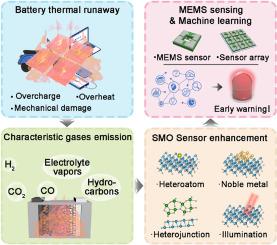Engineering semiconductor metal oxide nanostructures for chemiresistive gas sensors in early warning of battery thermal runaway
IF 12
1区 化学
Q1 CHEMISTRY, ANALYTICAL
引用次数: 0
Abstract
Thermal runaway in lithium-ion batteries poses significant safety challenges, often resulting in catastrophic fire and explosion incidents. Despite advancements in battery technology, the accurate detection and early warning of such events remain unresolved. This review examines the potential of semiconductor metal oxide (SMO)-based chemiresistive gas sensors to address critical battery safety challenges. Firstly, it describes the types of gases produced during battery thermal runaway (e.g., H2, CO, CO2, CH4) and their production mechanisms. Secondly, it highlights recent progress in designing and functionalizing SMOs for gas detection purposes, including heteroatom doping, noble metal loading, heterostructure construction, and light-induced excitation. Thirdly, it discusses the sensing performance of different characteristic gases during battery thermal runaway. Finally, it explores the integration of SMO materials onto MEMS sensors and the utilization of machine learning in gas sensing applications to enhance real-time safety monitoring in battery systems. This review underscores the urgent need for efficient and reliable semiconductor metal oxide sensors strategically integrated into battery management systems to mitigate thermal runaway risks. Future advances will hinge on enhancing sensing performance (e.g., selectivity, long-term stability) while coupling SMO sensors with machine learning to enable practical and intelligent early-warning capabilities.

工程半导体金属氧化物纳米结构用于化学阻性气体传感器的电池热失控预警
锂离子电池的热失控带来了重大的安全挑战,经常导致灾难性的火灾和爆炸事件。尽管电池技术取得了进步,但对此类事件的准确检测和早期预警仍然没有解决。本文综述了基于半导体金属氧化物(SMO)的化学气体传感器的潜力,以解决关键的电池安全挑战。首先,描述了电池热失控过程中产生的气体类型(如H2、CO、CO2、CH4)及其产生机理。其次,重点介绍了用于气体检测的SMOs的设计和功能化的最新进展,包括杂原子掺杂、贵金属负载、异质结构构建和光诱导激发。第三,讨论了电池热失控过程中不同特征气体的传感性能。最后,它探讨了SMO材料与MEMS传感器的集成,以及在气体传感应用中利用机器学习来增强电池系统的实时安全监测。这篇综述强调了迫切需要将高效可靠的半导体金属氧化物传感器战略性地集成到电池管理系统中,以减轻热失控的风险。未来的进展将取决于增强传感性能(例如,选择性,长期稳定性),同时将SMO传感器与机器学习相结合,以实现实用和智能的预警能力。
本文章由计算机程序翻译,如有差异,请以英文原文为准。
求助全文
约1分钟内获得全文
求助全文
来源期刊

Trends in Analytical Chemistry
化学-分析化学
CiteScore
20.00
自引率
4.60%
发文量
257
审稿时长
3.4 months
期刊介绍:
TrAC publishes succinct and critical overviews of recent advancements in analytical chemistry, designed to assist analytical chemists and other users of analytical techniques. These reviews offer excellent, up-to-date, and timely coverage of various topics within analytical chemistry. Encompassing areas such as analytical instrumentation, biomedical analysis, biomolecular analysis, biosensors, chemical analysis, chemometrics, clinical chemistry, drug discovery, environmental analysis and monitoring, food analysis, forensic science, laboratory automation, materials science, metabolomics, pesticide-residue analysis, pharmaceutical analysis, proteomics, surface science, and water analysis and monitoring, these critical reviews provide comprehensive insights for practitioners in the field.
 求助内容:
求助内容: 应助结果提醒方式:
应助结果提醒方式:


